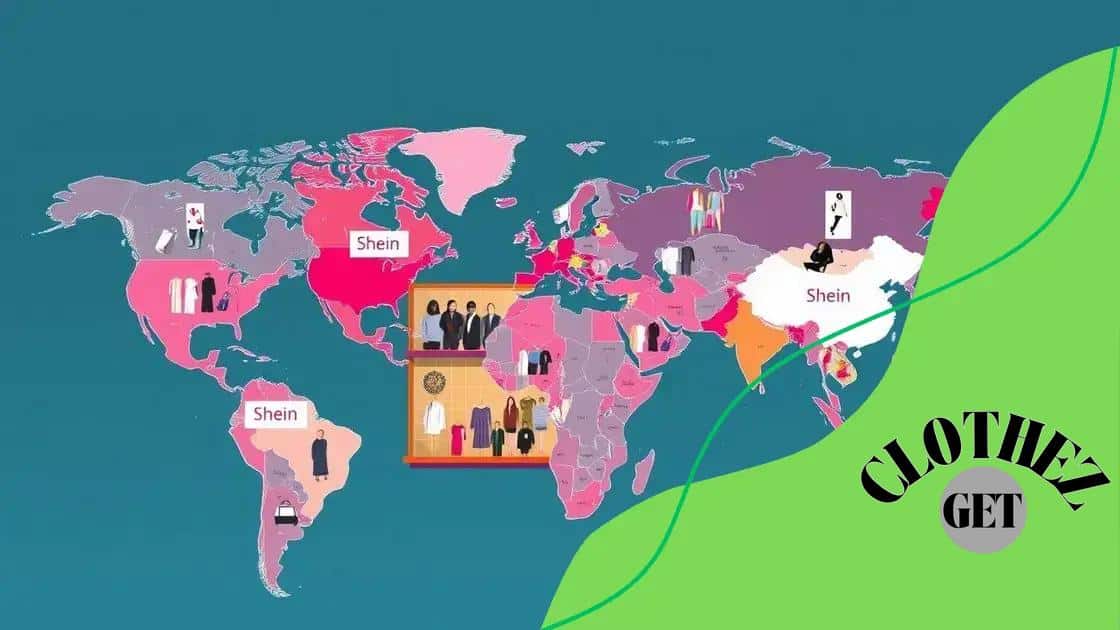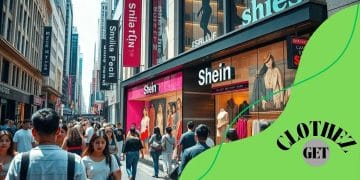Shein’s global expansion updates: what’s happening now

Shein’s global expansion updates highlight its focus on adapting to local fashion trends, navigating regulatory challenges, and leveraging technology to meet consumer demands in diverse markets.
Shein’s global expansion updates are making waves in the fashion world. As this popular retailer reaches new markets, it’s worth asking: what does this mean for the future of online shopping?
Overview of Shein’s global strategy
Shein’s global strategy has transformed the way consumers view fast fashion. Their approach focuses on adaptability and market responsiveness, making them a leader in the e-commerce realm.
In recent years, Shein has made significant strides in international markets. The company tailors its offerings based on local trends and preferences, which helps it resonate with diverse audiences. This level of customization is pivotal for success in various regions.
Key Components of Shein’s Strategy
One of the main strategies involves leveraging data analytics. Shein uses customer feedback to drive their design process. By analyzing sales trends and customer behavior, they can predict new styles before they become mainstream.
- Localization: Adapting products to meet local tastes.
- Rapid production: Short lead times allow quick shifts in style offerings.
- Digital marketing: Utilizing social media influencers to reach wider audiences.
This flexibility not only keeps their inventory fresh but also engages consumers who demand variety and responsiveness from brands. Another aspect of Shein’s global strategy involves partnerships with local influencers. These collaborations help Shein establish a presence in new markets while building trust with potential customers.
Challenges and Considerations
However, Shein’s rapid expansion is not without challenges. The company must navigate different regulations and market dynamics in each country. Additionally, concerns about sustainability and ethical production practices are rising in the fashion industry.
Consumers are becoming more aware of these issues, which could affect Shein’s long-term perception and sales. In response, Shein is working on improving transparency and incorporating sustainable practices into their supply chain. By facing these challenges head-on, Shein aims to remain a frontrunner in fast fashion while also addressing consumer concerns.
Key markets for Shein’s expansion
Shein’s expansion strategy focuses on penetrating key markets around the globe. By analyzing consumer behavior and preferences, the brand identifies which areas offer the greatest potential for growth.
Currently, major markets include the United States, Europe, and parts of Asia. Each of these regions brings unique opportunities and challenges, allowing Shein to tailor its offerings accordingly.
United States
In the United States, Shein has captured the attention of young adults and teens. Their extensive online marketing campaigns focus on social media platforms like Instagram and TikTok, which resonate well with this demographic. This focus on digital engagement not only drives sales but also builds a loyal customer base.
- Target Audience: Primarily Gen Z and millennials.
- Popular Products: Trendy apparel, swimwear, and accessories.
- Marketing Strategies: Collaborations with influencers and frequent promotions.
This vibrant marketing strategy has helped establish Shein as a household name. By continuing to innovate and connect with consumers, Shein aims to maintain its competitive edge.
Europe
Europe represents another significant market for Shein. The brand appeals to a diverse audience by offering styles that cater to local tastes and seasonal trends. In many European countries, fashion is a major part of cultural identity; thus, Shein adapts its collections accordingly. Fast shipping and local partnerships enhance the shopping experience.
- Countries of Focus: France, Germany, and the UK.
- Local Adaptation: Customizing styles based on regional preferences.
- Sustainability Efforts: Addressing eco-conscious consumer demands.
These measures help Shein not only to expand its reach but also to foster a positive brand image among European consumers.
Asia
In Asia, Shein’s growth strategy also looks promising. The brand acts on the fast-changing fashion cycles characteristic of this region. With an increasing number of online shoppers, Shein tailors its inventory to suit the local markets. This is achieved through agile supply chain management and a keen understanding of consumer trends.
Regions like Southeast Asia are particularly attractive due to rising incomes and a growing appetite for fast fashion. Shein’s ability to provide affordable, stylish options makes it popular with younger shoppers.
Impact of local trends on Shein’s growth

Local trends play a critical role in shaping Shein’s growth strategy. By closely monitoring fashion trends in various regions, Shein can create collections that align with local preferences. This approach helps the company appeal directly to new customers.
For instance, trends in urban areas often differ greatly from those in suburban or rural settings. Shein’s ability to adapt to these differences allows them to connect with a wider audience and enhance sales.
Cultural Influences
Cultural trends significantly influence consumer behavior. Shein studies local traditions and styles to ensure their offerings resonate with different audiences. Celebrations, festivals, and regional preferences contribute to the clothing choices of consumers. By aligning their products with these elements, Shein builds a strong emotional connection.
- Fashion Influencers: Collaborating with local fashionistas helps to introduce styles effectively.
- Seasonal Changes: Adapting collections based on local weather patterns.
- Feedback Mechanisms: Utilizing customer feedback to fine-tune inventory.
Such strategies enable Shein not only to remain relevant but also to build brand loyalty.
Fashion Trends Across Regions
The impact of local trends can be seen across varying markets. In the United States, streetwear and casual styles dominate, while in Asia, a mix of contemporary and traditional influences often shapes fashion choices. In Europe, the focus may shift more towards sustainable fashion, requiring Shein to adapt its production methods.
By staying attuned to these trends, Shein can quickly adjust its inventory and marketing strategies. This responsiveness is key to maintaining a competitive advantage in a fast-paced industry.
Moreover, Shein employs data analytics to track these trends effectively. By analyzing social media, customer purchases, and search data, Shein can pinpoint trends before they fully emerge. This proactive approach allows the brand to stay ahead of competitors while satisfying customer demands.
Challenges faced by Shein internationally
Shein faces various challenges as it expands internationally. As a global brand, navigating different markets involves understanding diverse regulations and competing in saturated marketplaces.
One of the primary obstacles includes adapting to local laws and policies. Each country has unique regulations concerning labor, trade, and environmental practices, which Shein must comply with. This complexity can impact production schedules and costs.
Regulatory Compliance
Compliance with international regulations is crucial for Shein’s success. In many regions, strict guidelines govern labor practices, product safety, and consumer rights. Failing to adhere to these rules can lead to significant fines and damage to Shein’s brand reputation.
- Labor Laws: Ensuring fair labor practices in manufacturing countries.
- Import Regulations: Navigating different tariffs and import duties.
- Environmental Standards: Meeting sustainability goals in production and logistics.
These regulatory challenges require Shein to be flexible and proactive in its operations.
Market Competition
Another notable challenge is market competition. Shein competes with established brands and local retailers in every market it enters. The fast fashion industry is highly competitive, with many companies vying for consumer attention.
To overcome this, Shein must differentiate itself through unique product offerings and effective marketing strategies. Engaging with influencers and utilizing social media platforms can help build brand loyalty among consumers.
The presence of local competitors also poses a threat. These brands often have a deeper understanding of customer preferences, making it essential for Shein to continually adapt its strategy.
Sustainability Concerns
With growing consumer awareness about environmental impact, Shein faces scrutiny regarding its sustainability efforts. Fast fashion is often criticized for contributing to waste and resource depletion. As consumers demand more transparency, Shein is challenged to improve its sustainability practices.
This involves re-evaluating its supply chain and exploring more eco-friendly materials. Customers increasingly favor brands that commit to ethical practices, making it vital for Shein to address these concerns.
Future predictions for Shein’s global presence
The future predictions for Shein’s global presence indicate a dynamic and rapidly evolving market strategy. As online shopping continues to grow, Shein is expected to expand its reach even further.
One key area for growth is the increasing demand for fast fashion. As consumers seek trendy and affordable clothing, Shein is well-positioned to meet these needs. The company’s agile supply chain allows for quick turnover of styles, keeping their inventory fresh and relevant.
Expanding into New Markets
Shein aims to penetrate untapped markets in South America, Africa, and the Middle East. Each of these regions presents unique opportunities due to rising disposable incomes and a growing appetite for fashion. By tailoring its offerings to local tastes, Shein can capture significant market share.
- Localized Marketing: Focus on culturally relevant marketing strategies.
- Partnerships: Collaborate with local influencers to build brand trust.
- Product Customization: Adapt styles based on regional preferences.
Such strategies will allow Shein to resonate deeply with new customers, driving growth in these areas.
Technological Innovation
Advancements in technology will also shape Shein’s future. The brand is leveraging data analytics to better understand customer behavior and preferences. This insight allows for more targeted marketing and inventory management.
Additionally, the use of artificial intelligence in design and customer service can enhance the shopping experience. Virtual fitting rooms and personalized recommendations are just some of the innovations poised to attract and retain customers.
Sustainability Efforts
As sustainability becomes increasingly important to consumers, Shein is expected to enhance its environmental initiatives. Future plans may include more eco-friendly materials and transparent supply chains. This aligns with the growing demand for ethical fashion choices.
Implementing these sustainability measures will be crucial for Shein to maintain its competitive edge and appeal to a more conscious consumer base.
In conclusion, Shein’s global expansion is marked by adaptability and innovation. The brand leverages local trends to stay relevant while addressing challenges in compliance and competition. As it looks to the future, Shein’s focus on technological advancements and sustainability will play a crucial role in its continued success. By understanding diverse markets and evolving with consumer demands, Shein is set to become a leading force in the global fashion industry.
FAQ – Frequently Asked Questions about Shein’s Global Expansion
What strategies is Shein using for international growth?
Shein is focusing on localized marketing, expanding into new markets, and collaborating with local influencers to increase its global presence.
How does Shein adapt to local fashion trends?
Shein closely monitors regional preferences and cultural influences to ensure its products align with local consumer demands.
What challenges does Shein face in different markets?
Shein encounters regulatory compliance requirements, intense competition, and sustainability concerns as it expands internationally.
What technological innovations is Shein implementing?
Shein is using data analytics and AI to improve inventory management and enhance customer experiences through personalized shopping options.





